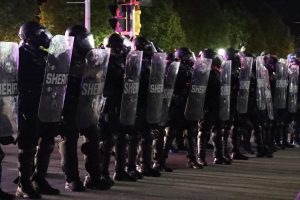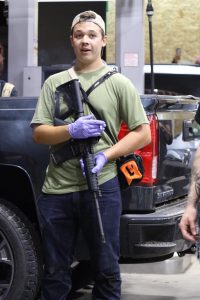Chaos in Kenosha: A UW Oshkosh alumnus shares experience on the ground
Police in riot gear are confronted by a group of people protesting systemic racism and police brutality. (Photo by Leviathan Whitfield)
October 7, 2020
As chaos began to envelop Kenosha in the late days of summer, following the Aug. 23 police shooting of Jacob Blake, UW Oshkosh alumnus Leviathan Whitfield traveled to the city to document the unrest.
Whitfield graduated from UWO in 2010 with a degree in English and Secondary Education. He has previously photographed other newsworthy events, such as former President Barack Obama’s inauguration and several of President Donald Trump’s rallies.
When he saw the unrest unfolding in Kenosha on the news, he felt compelled to document what was happening.

“I, initially, had reservations about going, but I did it anyway,” he said. “I had no idea that it was going to be that violent that evening.”
Two days after Blake was shot seven times by Kenosha police officer Rusten Sheskey, Whitfield arrived in the city with his camera in hand to witness the unrest unfolding in his home state.
He described pandemonium on the streets, as vehicles burned and police in riot gear roamed the streets.
Beyond police, Whitfield recalled seeing an armed militia of “counter protesters” roaming the streets as well, threatening those protesting systemic racism and police brutality.
The night he went to Kenosha, Aug. 25, also happened to be the night in which 17-year-old Illinois resident Kyle Rittenhouse shot three people, killing two protesters and injuring another.
Whitfield saw and photographed Rittenhouse that day, and was close enough to hear a few of the shots.
At first, Whitfield said Rittenhouse was walking around with a fire extinguisher, trying to put out fires. As the night wore on, however, Whitfield described Rittenhouse as gradually becoming more and more on-edge.
“It was a very tense situation, and I could sense it on him,” Whitfield said of Rittenhouse’s demeanor. For a reason that Whitfield still isn’t sure of, he decided to follow Rittenhouse as he made his way through the city.
At one point before the shootings, he saw Rittenhouse running down the street with an AR-15-style rifle toward Bert & Rudy’s Auto Service Shop in Kenosha.
Whitfield turned to talk to someone near the auto shop, and then he heard gunshots ring out.
“We didn’t know where the shots were coming from, so we hid in the bushes for about a minute or two,” Whitfield recalled. “Then Rittenhouse emerged from the parking lot and was running down the street. And again, my instinct was to follow him. People were saying that he had shot somebody, so I followed him.”
He followed Rittenhouse from the auto shop to an intersection, where Rittenhouse had fallen down and was confronted by two protesters.

“I was right up in it, but then when I heard the bullets, I ran out around into the bushes,” Whitfield said. “I sought cover because I didn’t know where these bullets were going to go.”
When Whitfield came out from behind the bushes, what he saw disturbed him.
“One of the men who tried to confront him, I guess the guy who was hitting him with a skateboard, was lying dead while someone was trying to resuscitate him,” Whitfield said. “I felt like it was dangerous at that point, so I stopped following and [Rittenhouse] continued to go the opposite direction in the street.”
Around that time, Whitfield saw a squad car with a police officer inside, so he approached and showed the officer a photo he had taken of Rittenhouse. The officer, however, appeared disinterested and “didn’t want to talk” to Whitfield.
Whitfield said police told people that night that they had a suspect in custody to appease the protesters. That was a lie, however, as Rittenhouse was arrested the following day, according to ABC News.
“I was kind of bothered by that,” Whitfield said of the police’s initial response to the shootings.
In fact, the police response to the entire situation disappoints Whitfield, who said police took a very “hands-off” approach to dealing with the unrest, which is part of the reason the unrest escalated.
“You didn’t need to have armed individuals there. Mr. Rittenhouse was from out-of-state, didn’t have a license for that firearm and he’s walking around the streets with a giant gun and his finger on the trigger,” Whitfield said. “I’m still not sure why that’s even acceptable.”
While Whitfield was filled with a sense of fear and anxiety when he was on the ground in Kenosha, he said the need to document what was happening kept him going and helped him persevere through the chaos.

“The reason I went there was to go and get those images, so I just went out and tried to overcome that fear, which didn’t last very long because instinct to get the images really took over,” he said. “Part of what drives me as a photographer is the need to get substantial evidence of something that’s taken place; it really doesn’t matter what assignment that I’m out on.”
Additionally, Whitfield has been disheartened by the media coverage of the unrest in Kenosha, as conservative media has aimed to paint Rittenhouse as a hero, trying to defend local businesses.
“This guy was agitated and he was getting nervous,” Whitfield said. “He was trying to do good, but I think he might have felt threatened in that parking lot and made a mistake.”
When he isn’t taking photos of historic events, Whitfield works as a school teacher in Milwaukee’s inner city, where he has seen systemic racism firsthand as an educator in one of America’s most segregated cities.
“I’ve just been able to see the things that other people don’t want to see in the inner city,” he said. “A lot of these students are not getting the same kind of education that you would get anywhere else. It’s lacking the structure due to the high turnover of teachers and a lack of credentialed teachers.”
Ultimately, Whitfield believes more needs to be done to eliminate equity gaps that exist between low-income students and students from wealthy families.
“I’ve been in Milwaukee teaching for about 10 years, and I’ve seen class after class of students passed over,” he said. “I think a lot of the racial tension that exists in the city is because we’re sending uneducated, unskilled students out into the workforce to become adults.”














